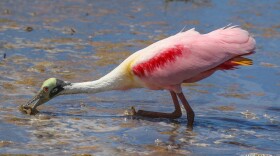
Mark Faherty
Host, The Weekly Bird ReportMark Faherty writes the Weekly Bird Report.
Mark has been the Science Coordinator at Mass Audubon’s Wellfleet Bay Wildlife Sanctuary since August 2007 and has led birding trips for Mass Audubon since 2002. While his current projects involve everything from oysters and horseshoe crabs to bats and butterflies, he has studied primarily bird ecology for the last 20 years, working on research projects in Kenya, Florida, Texas, California, Arizona, Mexico, and the Pacific Northwest. He was a counter for the famous River of Raptors hawk watch in Veracruz, Mexico, and has birded Africa, Panama, Belize, and both Eastern and Western Europe. Mark is an emcee and trip leader for multiple birding festivals and leads workshops on birding by ear, eBird, birding apps, and general bird identification. He is past president of the Cape Cod Bird Club and current member of the Massachusetts Avian Records Committee.
-
-
Big flocks of birds tend to draw in other birds, including any lost waifs from elsewhere. Sometimes just looking out the window can reveal a rare bird in your yard.
-
The Atlantic puffin is a real crowd-pleaser. While people know them as a nesting bird of rocky Maine Islands in summer, small numbers winter in deep Massachusetts waters.
-
A limpkin visited Scituate and a common cuckoo visited New Hampshire in recent days.
-
Turkeys have a role to play in the emergence of that pest du jour, the Lone Star Tick, and the weird red-meat allergy they transmit, alpha-gal syndrome. You could say that when it comes to alpha-gal, turkeys giveth, and turkeys taketh away.
-
Townsend’s Solitaire is the only US representative of a group of mostly mountain dwelling thrushes of Central and South America, plus Hawaii somehow, and are some of my favorite birds. They are related to our bluebirds and robins but are better singers than both.
-
A common theme on the bird report is the omnidirectional origins of the interesting birds we see, especially in fall – in any given week we may see lost birds from Europe, Western Canada, the Caribbean, and the desert southwest. This week is a good example, with species hailing from all of these destinations making landfall on the Cape.
-
Brown Boobies look a lot like young gannets, which are various shades of brown, but unlike gannets, they will sit on rocks close to shore for long periods – gannets essentially never come ashore around here unless they’re sick.
-
With All Hallows Eve rapidly approaching, I thought it was high time to explore the spookier side of birds.
-
Roseate Spoonbills are a Florida bird to us easterners, but most of their range is in South America.











